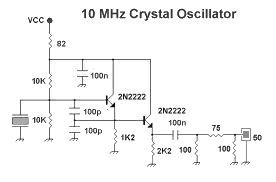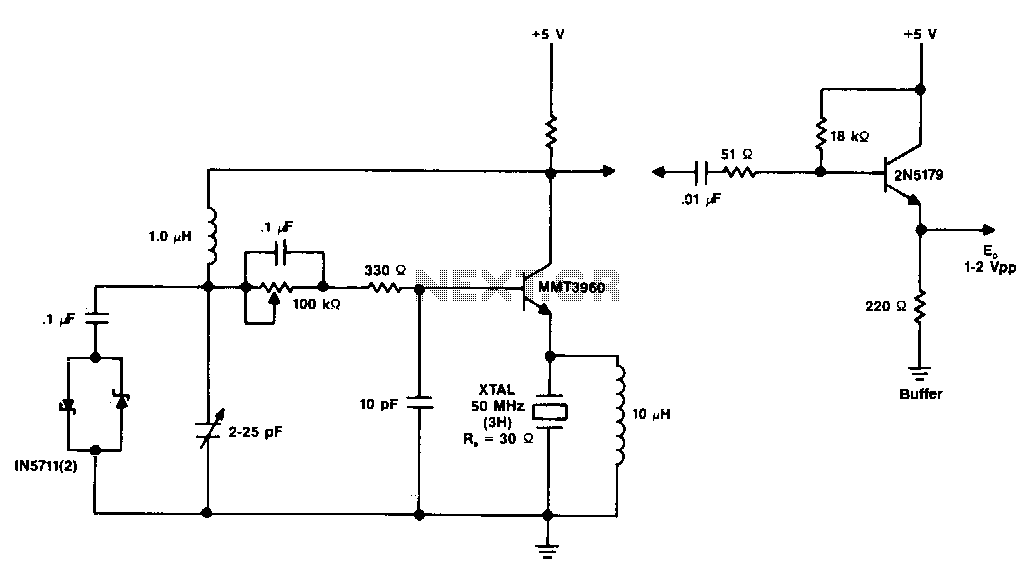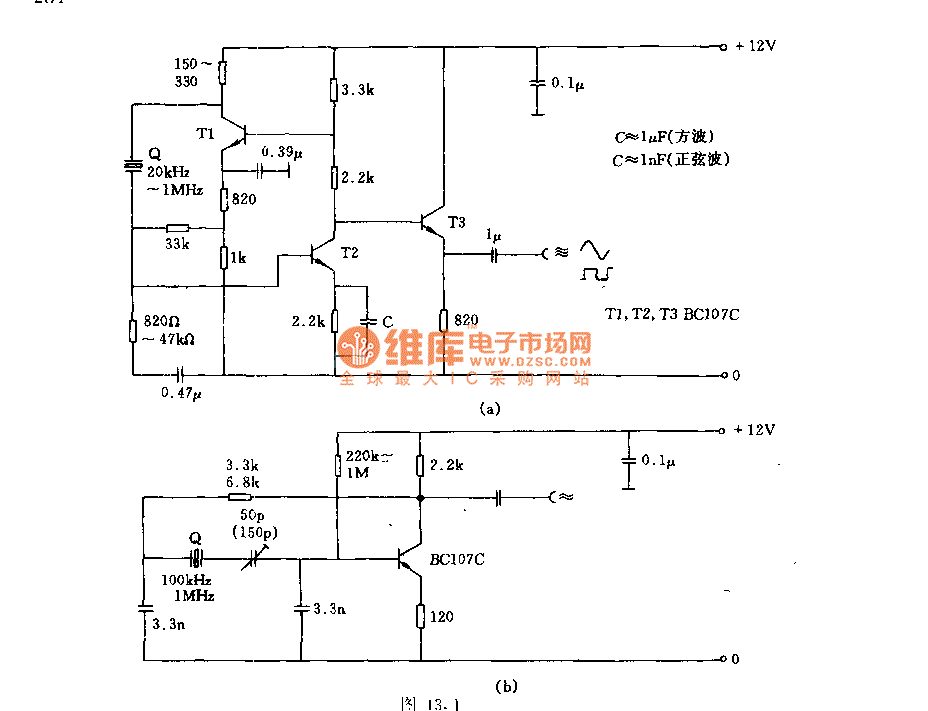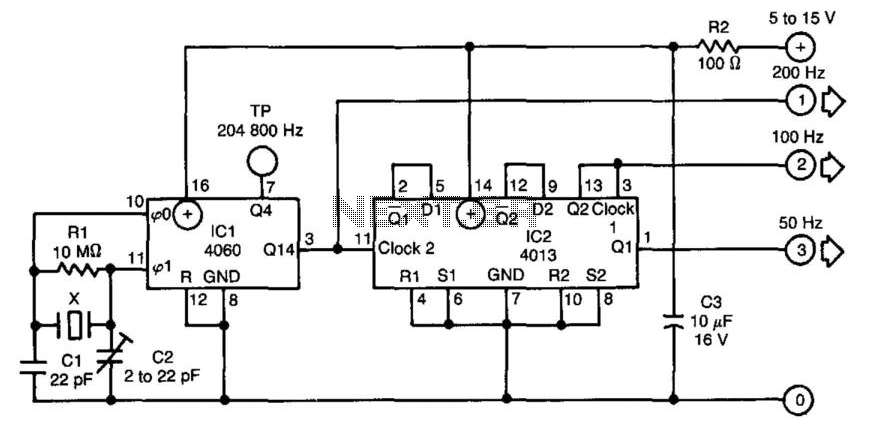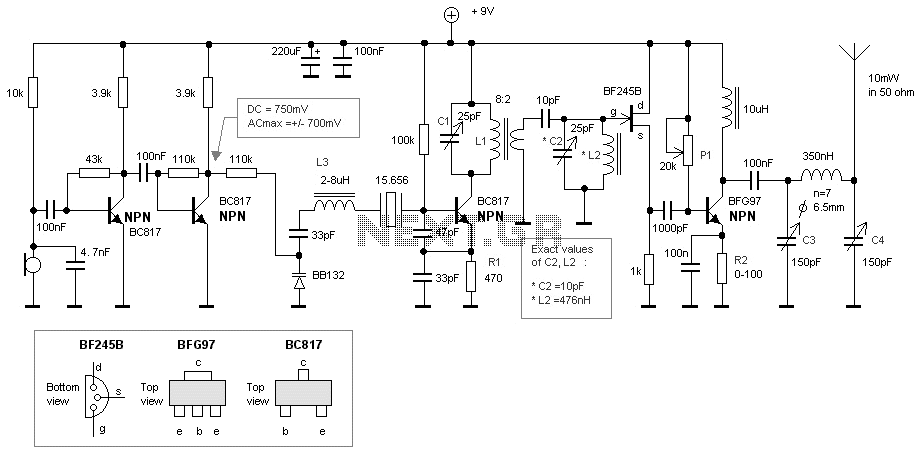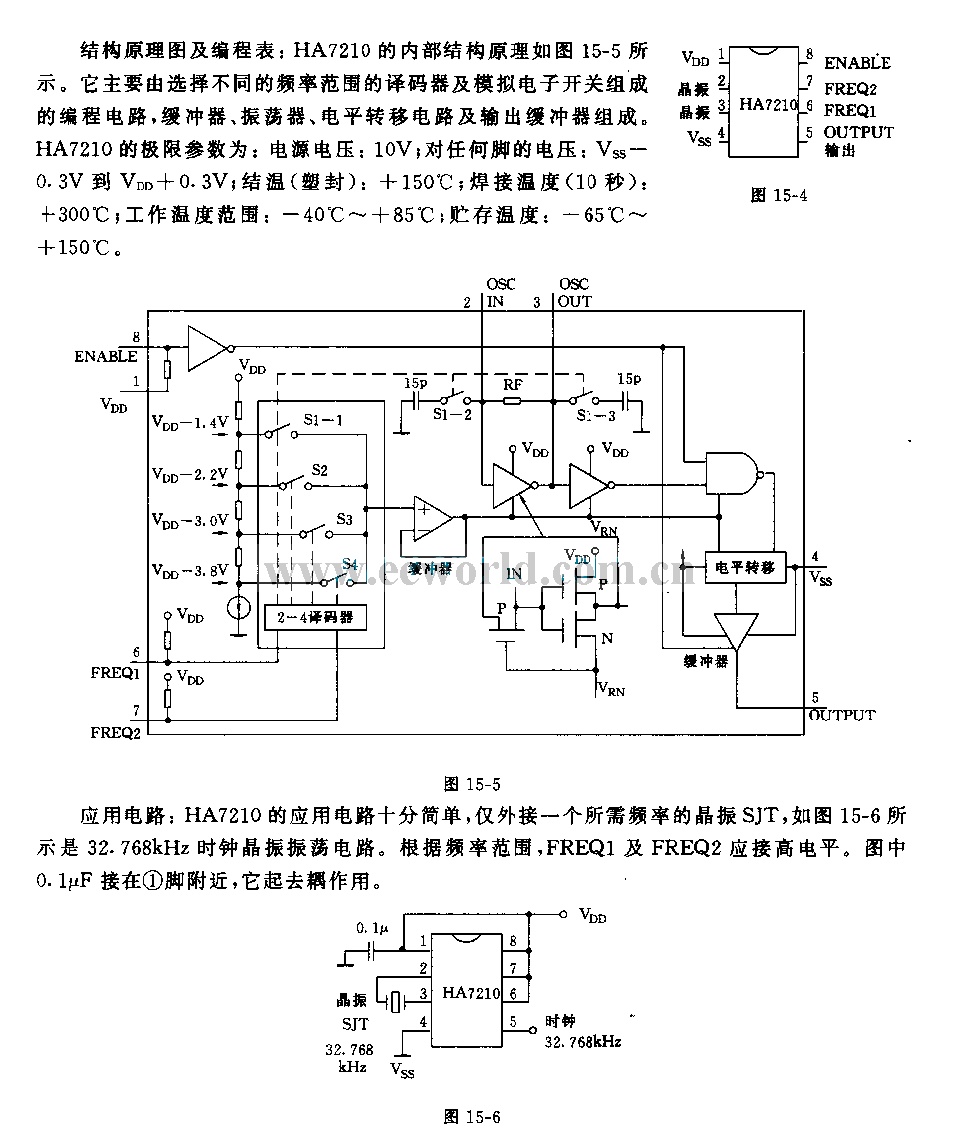
Crystal oscillators
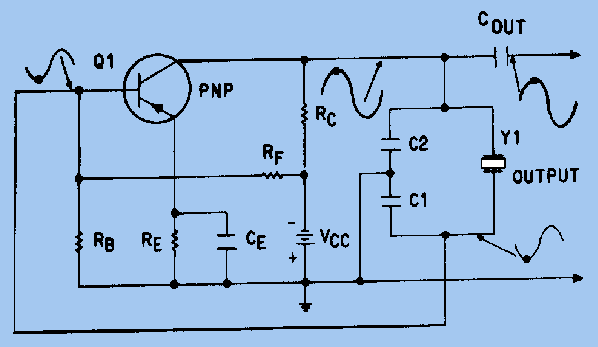
Crystal oscillators are devices where a specially cut crystal regulates the frequency. Crystal-controlled oscillators are the standard method for maintaining the frequency of radio transmitting stations within their designated limits. These oscillators typically produce an output that is highly stable and precise. Crystals used in electrical circuits are thin sheets cut from natural crystals and ground to the appropriate thickness for the desired resonant frequency. For any specific crystal cut, a thinner crystal corresponds to a higher resonant frequency. The term "cut" (e.g., X, Y, AT) refers to the specific manner in which the usable crystal is extracted from the natural crystal. Transmitters requiring a high degree of frequency stability, such as broadcast transmitters, utilize temperature-controlled ovens to maintain a constant crystal temperature. These ovens are thermostatically regulated containers housing the crystals. The specific cut of the crystal also influences its activity; some crystals can vibrate at multiple frequencies, thereby operating at harmonic frequencies. Crystals with non-uniform thickness may exhibit two or more resonant frequencies, with one typically being more dominant than the others, while the less pronounced frequencies are known as spurious frequencies. Occasionally, a crystal may oscillate at two frequencies simultaneously. The safe current range for a crystal is between 50 to 200 milliamperes; exceeding this limit can lead to excessive mechanical vibration, risking crystal damage. Overloading affects the vibration frequency, as power dissipation and crystal temperature rise with increased load current. A quartz crystal and its equivalent circuit demonstrate this concept. Capacitor C2, inductor L1, and resistor R1 represent the electrical equivalent of the quartz crystal, while capacitance C1 denotes the capacitance between the crystal electrodes. Depending on circuit characteristics, the crystal can function as a capacitor, an inductor, a series-tuned circuit, or a parallel-tuned circuit. At a specific frequency, the reactances of equivalent capacitor C1 and inductor L1 will balance, allowing the crystal to act as a series-tuned circuit, characterized by minimum impedance at resonance. Above this resonance, the circuit behaves inductively, and below it, capacitively. Consequently, the crystal unit exhibits its lowest impedance at the series-resonance frequency, with impedance increasing as the frequency is lowered or raised beyond this point. Conversely, at certain frequencies above the series-resonant point, the crystal unit behaves as a parallel-tuned circuit, which has maximum impedance at the parallel-resonant frequency and acts inductively below this resonance. The frequency stability of crystal-controlled oscillators is contingent upon the quality factor (Q) of the crystal, which is exceptionally high, often exceeding 100 times that of an equivalent electrical circuit.
Crystal oscillators are integral components in various electronic devices, particularly in communication systems, due to their ability to provide stable and precise frequency outputs. The design of a crystal-controlled oscillator typically includes a crystal resonator, an amplifier, and feedback circuitry to ensure sustained oscillation at the desired frequency. The crystal resonator serves as the frequency-determining element, while the amplifier boosts the oscillation signal to a usable level. Feedback circuitry is crucial for maintaining oscillation, as it ensures that a portion of the output signal is fed back to the input in phase, reinforcing the oscillation.
The choice of crystal cut is significant, as different cuts can yield varying frequency characteristics and temperature stability. For instance, AT-cut crystals are widely used due to their favorable temperature stability and low frequency drift, making them suitable for applications in oscillators and filters. The implementation of temperature-controlled ovens, particularly in high-stability applications, mitigates frequency variations caused by temperature fluctuations, thereby enhancing performance.
In practical applications, the output of a crystal-controlled oscillator can be interfaced with various electronic circuits, including mixers, modulators, and frequency dividers. The high Q factor of the crystal not only contributes to frequency stability but also minimizes phase noise, which is critical in communication systems. The design and selection of components in the oscillator circuit must align with the desired operating frequency and stability requirements, ensuring optimal performance in the intended application.
Overall, crystal-controlled oscillators play a vital role in modern electronics, providing reliable frequency references essential for the functionality of a wide range of devices, from simple clocks to complex communication systems. Their ability to maintain precise frequency outputs under varying conditions makes them indispensable in the field of electronics engineering.Crystal oscillators are those in which a specially-cut crystal controls the frequency. CRYSTAL-CONTROLLED OSCILLATORS are the standard means used for maintaining the frequency of radio transmitting stations within their assigned frequency limits. A crystal-controlled oscillator is usually used to produce an output which is highly stable and at a v
ery precise frequency. As stated earlier, crystals used in electrical circuits are thin sheets cut from the natural crystal and are ground to the proper thickness for the desired resonant frequency. For any given crystal cut, the thinner the crystal, the higher the resonant frequency. The "cut" (X, Y, AT, and so forth) of the crystal means the precise way in which the usable crystal is cut from the natural crystal.
Some typical crystal cuts may be seen in figure 2-19. Transmitters which require a very high degree of frequency stability, such as a broadcast transmitter, use temperature-controlled ovens to maintain a constant crystal temperature. These ovens are thermostatically controlled containers in which the crystals are placed. The type of cut also determines the activity of the crystal. Some crystals vibrate at more than one frequency and thus will operate at harmonic frequencies. Crystals which are not of uniform thickness may have two or more resonant frequencies. Usually one resonant frequency is more pronounced than the others. The other less pronounced resonant frequencies are referred to as SPURIOUS frequencies. Sometimes such a crystal oscillates at two frequencies at the same time. The amount of current that can safely pass through a crystal ranges from 50 to 200 milliamperes. When the rated current is exceeded, the amplitude of mechanical vibration becomes too great, and the crystal may crack.
Overloading the crystal affects the frequency of vibration because the power dissipation and crystal temperature increase with the amount of load current. A quartz crystal and its equivalent circuit are shown in figure 2-20, views (A) and (B). Capacitor C2, inductor L1, and resistor R1 in view (B) represent the electrical equivalent of the quartz crystal in view (A).
Capacitance C1 in (view B) represents the capacitance between the crystal electrodes in view (A). Depending upon the circuit characteristics, the crystal can act as a capacitor, an inductor, a series-tuned circuit, or a parallel-tuned circuit. At some frequency, the reactances of equivalent capacitor C1 and inductor L will be equal and the crystal will act as a series-tuned circuit.
A series-tuned circuit has a minimum impedance at resonance (figure 2-21). Above resonance the series-tuned circuit acts INDUCTIVELY, and below resonance it acts CAPACITIVELY. In other words, the crystal unit has its lowest impedance at the series-resonance frequency. The impedance increases as the frequency is lowered because the unit acts as a capacitor. The impedance of the crystal unit also increases as the frequency is raised above the series-resonant point because the unit acts as an inductor. Therefore, the crystal unit reacts as a series-tuned circuit. Since the series-tuned circuit acts as an inductor above the resonant point, the crystal unit becomes equivalent to an inductor and is parallel with the equivalent capacitor C1 (view (B) of figure 2-20).
At some frequency above the series-resonant point, the crystal unit will act as a parallel-tuned circuit. A parallel-tuned circuit has a MAXIMUM impedance at the parallel-resonant frequency and acts inductively below parallel resonance (figure 2-21).
Therefore, at some frequency, depending upon the cut of the crystal, the crystal unit will act as a parallel-tuned circuit. The frequency stability of crystal-controlled oscillators depends on the Q of the crystal. The Q of a crystal is very high. It may be more than 100 times greater than that obtained with an equivalent electrical circuit. The Q of the crystal is determined 🔗 External reference
Crystal oscillators are integral components in various electronic devices, particularly in communication systems, due to their ability to provide stable and precise frequency outputs. The design of a crystal-controlled oscillator typically includes a crystal resonator, an amplifier, and feedback circuitry to ensure sustained oscillation at the desired frequency. The crystal resonator serves as the frequency-determining element, while the amplifier boosts the oscillation signal to a usable level. Feedback circuitry is crucial for maintaining oscillation, as it ensures that a portion of the output signal is fed back to the input in phase, reinforcing the oscillation.
The choice of crystal cut is significant, as different cuts can yield varying frequency characteristics and temperature stability. For instance, AT-cut crystals are widely used due to their favorable temperature stability and low frequency drift, making them suitable for applications in oscillators and filters. The implementation of temperature-controlled ovens, particularly in high-stability applications, mitigates frequency variations caused by temperature fluctuations, thereby enhancing performance.
In practical applications, the output of a crystal-controlled oscillator can be interfaced with various electronic circuits, including mixers, modulators, and frequency dividers. The high Q factor of the crystal not only contributes to frequency stability but also minimizes phase noise, which is critical in communication systems. The design and selection of components in the oscillator circuit must align with the desired operating frequency and stability requirements, ensuring optimal performance in the intended application.
Overall, crystal-controlled oscillators play a vital role in modern electronics, providing reliable frequency references essential for the functionality of a wide range of devices, from simple clocks to complex communication systems. Their ability to maintain precise frequency outputs under varying conditions makes them indispensable in the field of electronics engineering.Crystal oscillators are those in which a specially-cut crystal controls the frequency. CRYSTAL-CONTROLLED OSCILLATORS are the standard means used for maintaining the frequency of radio transmitting stations within their assigned frequency limits. A crystal-controlled oscillator is usually used to produce an output which is highly stable and at a v
ery precise frequency. As stated earlier, crystals used in electrical circuits are thin sheets cut from the natural crystal and are ground to the proper thickness for the desired resonant frequency. For any given crystal cut, the thinner the crystal, the higher the resonant frequency. The "cut" (X, Y, AT, and so forth) of the crystal means the precise way in which the usable crystal is cut from the natural crystal.
Some typical crystal cuts may be seen in figure 2-19. Transmitters which require a very high degree of frequency stability, such as a broadcast transmitter, use temperature-controlled ovens to maintain a constant crystal temperature. These ovens are thermostatically controlled containers in which the crystals are placed. The type of cut also determines the activity of the crystal. Some crystals vibrate at more than one frequency and thus will operate at harmonic frequencies. Crystals which are not of uniform thickness may have two or more resonant frequencies. Usually one resonant frequency is more pronounced than the others. The other less pronounced resonant frequencies are referred to as SPURIOUS frequencies. Sometimes such a crystal oscillates at two frequencies at the same time. The amount of current that can safely pass through a crystal ranges from 50 to 200 milliamperes. When the rated current is exceeded, the amplitude of mechanical vibration becomes too great, and the crystal may crack.
Overloading the crystal affects the frequency of vibration because the power dissipation and crystal temperature increase with the amount of load current. A quartz crystal and its equivalent circuit are shown in figure 2-20, views (A) and (B). Capacitor C2, inductor L1, and resistor R1 in view (B) represent the electrical equivalent of the quartz crystal in view (A).
Capacitance C1 in (view B) represents the capacitance between the crystal electrodes in view (A). Depending upon the circuit characteristics, the crystal can act as a capacitor, an inductor, a series-tuned circuit, or a parallel-tuned circuit. At some frequency, the reactances of equivalent capacitor C1 and inductor L will be equal and the crystal will act as a series-tuned circuit.
A series-tuned circuit has a minimum impedance at resonance (figure 2-21). Above resonance the series-tuned circuit acts INDUCTIVELY, and below resonance it acts CAPACITIVELY. In other words, the crystal unit has its lowest impedance at the series-resonance frequency. The impedance increases as the frequency is lowered because the unit acts as a capacitor. The impedance of the crystal unit also increases as the frequency is raised above the series-resonant point because the unit acts as an inductor. Therefore, the crystal unit reacts as a series-tuned circuit. Since the series-tuned circuit acts as an inductor above the resonant point, the crystal unit becomes equivalent to an inductor and is parallel with the equivalent capacitor C1 (view (B) of figure 2-20).
At some frequency above the series-resonant point, the crystal unit will act as a parallel-tuned circuit. A parallel-tuned circuit has a MAXIMUM impedance at the parallel-resonant frequency and acts inductively below parallel resonance (figure 2-21).
Therefore, at some frequency, depending upon the cut of the crystal, the crystal unit will act as a parallel-tuned circuit. The frequency stability of crystal-controlled oscillators depends on the Q of the crystal. The Q of a crystal is very high. It may be more than 100 times greater than that obtained with an equivalent electrical circuit. The Q of the crystal is determined 🔗 External reference
